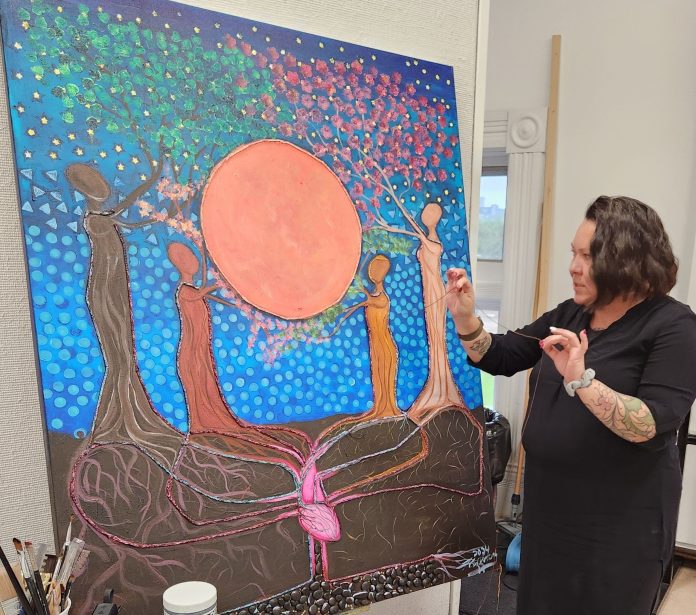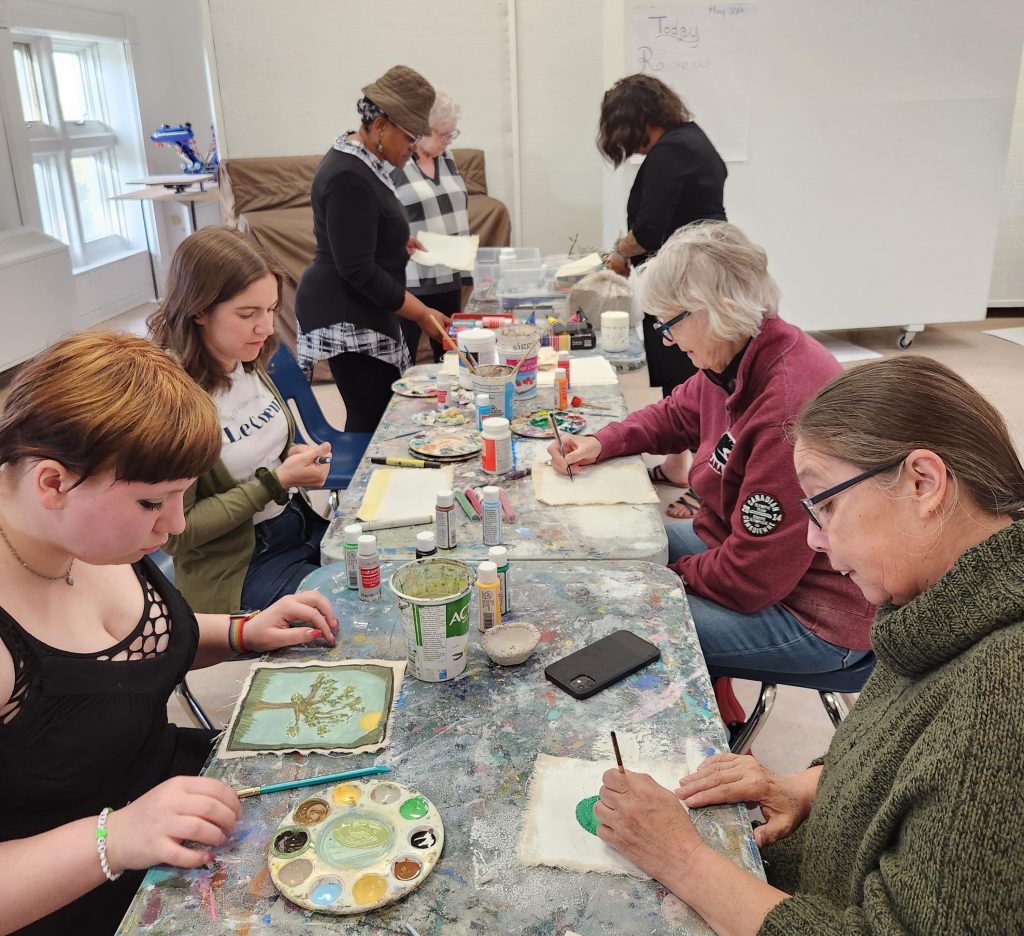
Glenda Goertzen
Special to the Daily Herald
Artist Harmony Johnson-Harder leads a demanding and diverse life. She graduated during the pandemic with a certificate in Indigenized Expressive Arts, but with a career spanning politics, yoga instruction, program management, and leaderships roles with various Saskatchewan arts organizations, how does she find time to create?
“I don’t,” she said in an interview Friday evening. “That’s why this residency is so important. I’ve stepped away from careers and volunteer work to focus primarily on the things that I love to do, and that’s creating and creating art.”
Harmony Johnson-Harder is a Cree Métis woman of the Montreal Lake Cree Nation, currently living in Prince Albert. The residency she referred to is taking place at the Margo Fournier Arts Centre on Central Avenue from May 27th to June 14th. The project is titled “Finding Our Common Stories” and includes a series of six workshops.
The initiative brings together Indigenous and newcomer women to connect, share their stories, and contribute to a collaborative project using various materials that incorporate the participants’ cultural styles. The residency is supported by the Prince Albert Council for the Arts and the City of Prince Albert Community Grant Program. The idea for the project was a collaboration between Johnson-Harder and Jesse Campbell, Coordinator/Curator with the City of Prince Albert Artists in Communities program.
“There’s a lot of misunderstanding for newcomers and a lot of misunderstanding of Indigenous peoples, particularly indigenous women,” Johnson-Harder explained when discussing how the project came about. “We see a lot of the vulnerability in our community and I want to be able to elevate voices and understanding and start shining positive lights on each other as opposed to all the negative things and all the trauma and the tragedies that are happening right now. Let’s start looking at things differently. Planting seeds.”
Seeds and roots, particularly those of trees, play a strong role in Johnson-Harder’s works. Among her artistic inspirations she listed Canadian Indigenous artists Ioyan Mani (Maxine Noel), Christi Belcourt and Leah Dorian. She added that the artist who had the strongest impact on her was her own grandmother, Mary Johnson.
“She was an artist in her own right; beading moccasins and sewing and beading jackets and vests. I was just recently gifted this hawk feather fan with this beaded medallion and all these feathers, and it’s nailed together on a piece of cardboard and glued. You could tell she didn’t have any money, but you could just see how creative she was. And that’s how I grew up. She taught me to bead, she taught me to sew, and we were creative with whatever we had laying around.”
In 2018, the memory of her grandmother and great-grandmother inspired Johnson-Harder to collaborate on a project with her father, Harold Johnson, Indigenous Crown prosecutor and author of Firewater: How Alcohol is Killing My People (and Yours). The story written by Johnson was called Kokum Magic, and Johnson-Harder created a painting by the same name.
Her most recent work, on display at the Margo Fournier Arts Centre, is Our Common Story. With the support of the Saskatchewan Arts Board she finished it in February, barely in time for the Winter Festival Art Show and Sale.
“It went in wet,” she admitted. “The paint was still drying.”
Even now the work is not quite finished. Johnson-Harder described how she would be adding more textiles to emphasize the theme of connection.
Connection is expertly fostered by Johnson-Harder in the workshops. In addition to collaborative art projects, each workshop includes a sharing circle, discussions and opportunities for visiting. The first project she assigned the group was to paint a symbol of womanhood. The surprising results created a new topic for discussion.
“Every woman had at least one element of earth: air, fire and water. It wasn’t even pre-planned. They found that simple and they related to that, to the elements of the earth. It’s where we live. I thought that was really awe-inspiring.”
Community connection was a strong motivation for participant Majdaleen Al Asmi to attend the workshops. As she and her children worked on their paintings Friday evening, Al Asmi mentioned that her family was the first Syrian refugee family to settle in Prince Albert in 2015.

Workshop participants find common ground in painting.
“If you have your neighbours and you don’t know anything about them, this place teaches something about them,” she said when reflecting on what she enjoyed about the workshops. “Maybe in the future you can help them with anything or if they need anything from you it’s easy; you know something about them now.”
She looked forward to a final collaborate project Johnson-Harder is guiding the participants toward.
“We all have one hand on it.”
The collaborative artworks will be shared with the public at a reception on June 14th, but visitors are welcome to view them anytime before then at the Margo Fournier Arts Centre. Harmony Johnson-Harder will be in residence from 10 a.m. to 4 p.m., Monday to Friday. The workshops take place Tuesdays at noon and Thursdays at 7 p.m. until June 13th. This week, Elder Liz Settee will be in attendance.
When asked what she hoped participants would take away from the workshops, Johnson-Harder replied, “Friendship. Relationships. If we don’t have an end piece of art that’s OK, because the art in the making is creating relationships. That’s all. If somebody walks out of here and they’ve created a lifelong friend, to me that’s a success.”

